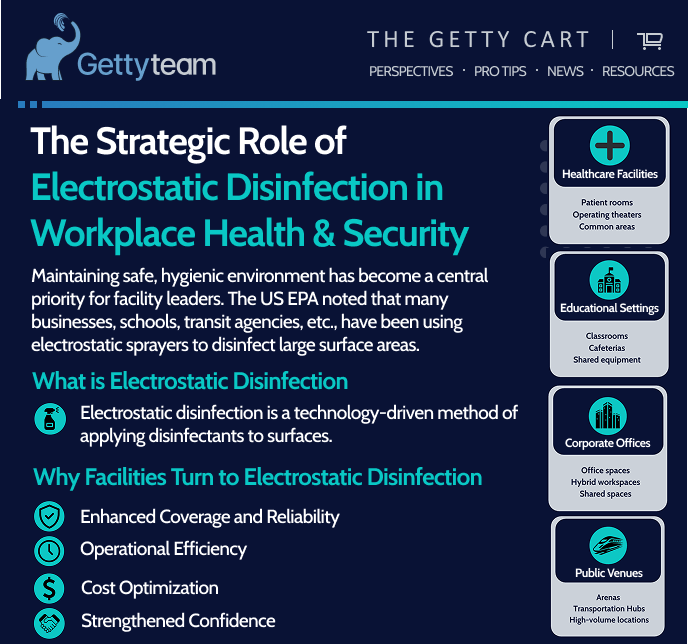Maintaining safe, hygienic environments has become a central priority for facility leaders across industries. Electrostatic disinfection has emerged as one of the most effective solutions to meet these standards, offering both efficiency and measurable impact. The U.S. EPA has noted that many businesses, schools, transit agencies, etc., have been using electrostatic sprayers to disinfect large surface areas.
What is Electrostatic Disinfection
Electrostatic disinfection is a technology-driven method of applying disinfectants to surfaces. The process involves charging liquid disinfectant droplets as they are sprayed. These charged particles are naturally attracted to surfaces, wrapping around objects and covering areas that are often missed by conventional cleaning methods.
The result is a uniform, 360-degree layer of disinfectant that reaches high-touch, hard-to-reach, and irregular surfaces. This level of coverage makes electrostatic spraying particularly effective in reducing pathogens, including bacteria and viruses, in complex facility environments.
Why Facilities are Turning into Electrostatic Disinfection
Several factors are driving adoption of electrostatic technology in professional cleaning and maintenance programs:
- Enhanced Coverage and Reliability
Traditional cleaning methods often leave gaps, particularly in areas with complex surfaces. Electrostatic application ensures consistent coverage, reducing the risk of missed spots. - Operational Efficiency
Facilities teams can cover larger areas in less time. This efficiency is particularly valuable in high-traffic spaces such as airports, schools, hospitals, and corporate campuses where downtime must be minimised. - Cost Optimization
By delivering disinfectants more evenly and reducing waste, electrostatic systems help optimize chemical usage. This can translate into lower long-term costs without compromising on hygiene standards. - Strengthened Confidence
Beyond operational benefits, visible use of advanced cleaning technology helps reassure employees, tenants, and visitors that the facility prioritises health and safety.
Why Facilities are Turning into Electrostatic Disinfection
EPA notes that businesses and institutions such as airlines, schools and transit agencies have been using electrostatic sprayers and that use increased substantially during the COVID period. While suitable for a wide range of environments, electrostatic disinfection provides particular advantages in:
- Healthcare facilities: Reducing infection risks in patient rooms, operating theatres, and common areas.
- Education settings: Providing consistent coverage across classrooms, cafeterias, and shared equipment.
- Corporate offices: Supporting hybrid workplace strategies with high-standard cleanliness in shared spaces.
- Public venues: Maintaining hygiene in arenas, transportation hubs, and other high-volume locations.
Conclusion
Electrostatic disinfection is not a standalone solution; it is most effective when integrated into a broader facility maintenance strategy that includes routine cleaning, ventilation management, and ongoing risk assessment.
As expectations for clean, safe environments continue to rise, facilities that adopt advanced disinfection technologies position themselves to meet regulatory requirements, manage costs, and build trust with stakeholders.


